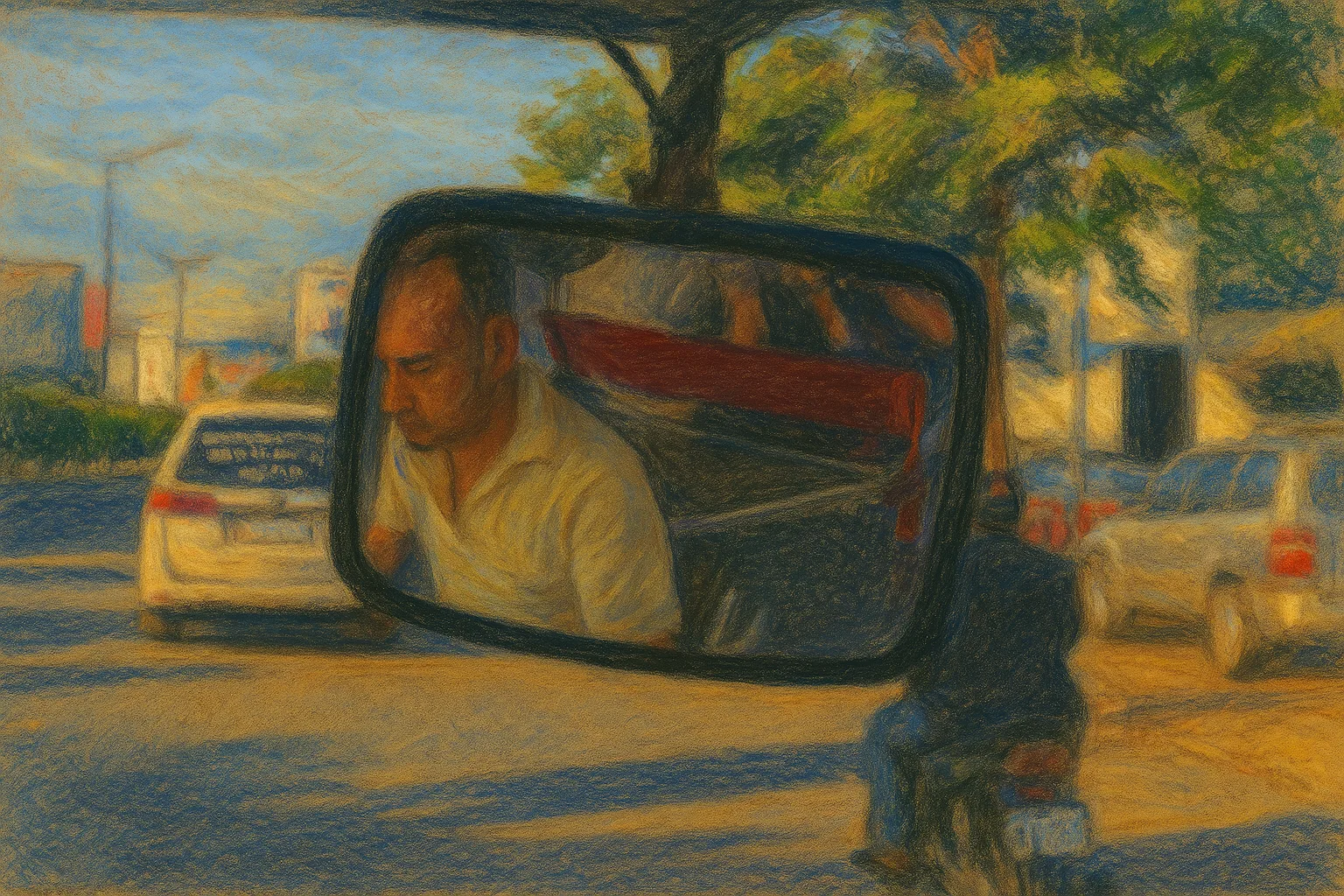It’s now been a week since I arrived in Cambodia — just as I mentioned in my first article, the day before leaving. This is actually my return to the country, where I previously completed a humanitarian internship and lived among Cambodians, fully immersed in their culture and way of life. This time, I arrived with a small group of friends. For the first few days, we chose rest mode and discovery of the capital: four days in Phnom Penh, and a scooter trip to Skuon — the town of tarantulas — about one hour away. Perfect for October (Halloween season) and for triggering gag reflexes in the faint-hearted. These interludes serve as a breath of air in my blog — and as a way of sharing an experience that is far more sensory than it first appears.
Once there, everything becomes real: the noise, the heat, the fatigue. When we arrived in the capital, we had to organize ourselves: collect our luggage, buy eSIM cards and phone plans — cheaper than French carriers — and rent a van for our adventures. And above all, make it to the hotel after nearly 24 hours of travel, including 15 hours of flights. I get tired quickly, so the journey drained me. Especially since I barely slept the entire time.
On top of that, there are three bipolar-related challenges I have to manage: the jet lag, changing medication schedules, and the malaria treatment. All three can trigger mood instability, especially the anti-malaria medication, which we suspect played a major role in the depressive episode I experienced during my first trip to Cambodia. As for jet lag, I gradually shifted my medication times as we traveled, until I was back on the correct schedule two days later.
So these are the first days of a chaotic return to a country I love so deeply.
Day 1
Despite being exhausted, we arrived at the hotel to drop off our bags, and — unexpectedly — it wasn’t the smell of the city that hit me this time. It was the omnipresent incense filling the hotel lobby, where we had to wait because there was an issue with our booking.
I tried to convince some people in the group to go to the market and buy local chips (by which I mean: grilled crickets). In the end, we went to a small restaurant and had a meal for… 3 dollars. There, that’s the equivalent of a 15-euro dish. Five times cheaper. After a year of impulsive manic spending, my wallet is thrilled. During my first trip, I only tried about three local dishes — sticking to what I knew, where I could predict the outcome. This time, I promised myself something different: to try new things and step out of my comfort zone. Like I said, this is a sensory adventure, and I don’t want to miss any part of it.

On the way, there’s the joy of rediscovering chaotic roads where the only real rule is the absence of rules… except for tourists, whom the police take great pleasure in stopping for absurd reasons. In Paris, road chaos follows no logic. In Cambodia, despite cars casually driving the wrong way, there seems to be an order only Cambodians understand. The noise becomes almost melodic. But it hides a rather terrifying reality: the number of accidents here is far higher. Seatbelts weren’t invented for nothing. And you’d better avoid stepping onto the road without caution… you risk getting run over badly.
The street is a sensory overload — blazing sunlight, the noise of scooters and tuk-tuks rushing past. No rest for me; I had to wait until the end of the day to finally breathe and sleep in peace in a simple room.
Day 2
The next day was dedicated to visiting the city and taking photos — one of my favorite pastimes when I travel. First at the Royal Palace near Riverside (the western bank of the Tonlé Sap river, which runs through the city), then to Silk Island, known for silk clothing production, which costs a small fortune for Khmer people. I bought a beautiful silk pair of pants — soft beyond words — to survive the heat. It was also a chance to see the whole process made by hand. I was fascinated by the mechanism used to produce silk thread.


And finally, that same day, in the spirit of culinary exploration, I ended up in a highly recommended restaurant with delicious dishes — including one I had already tried in that exact same place eight years earlier. I had forgotten, but the taste slowly gave it away.
Day 3
Just before leaving the city, day three was the moment I hit my sensory limit. Lunch in a French-Cambodian restaurant, then a walk through the Russian Market. It’s the kind of market where you can find fruit, clothes, shoes (like “Agidas”) right next to stalls selling nails, plumbing supplies, jewelry, or street food (skewers, soups, noodles, fertilized eggs, grilled octopus). You can find nearly anything imaginable as long as it fits inside a market.
It’s loud and very lively — but I did manage to take a small break with fresh mango smoothies that taste nothing like the fruit you find in France. (I could write an entire article about Cambodian fruits — or tropical ones in general, the kind I grew up eating during my 12 years in Guadeloupe.)

What finally broke me was the Kun Khmer fight (Cambodian boxing). A sport where every strike seems allowed and where blood appears quickly. But the real chaos was the atmosphere inside — a venue clearly not designed to host the thousand people (according to our estimate) packed into it. The crowd went wild at every hit. That finished draining me after a long day and very little sleep. A good night’s rest, a shutdown narrowly avoided (until…), and then we were ready for…
Day 4
…another intense day, after realizing I had exchanged 200 euros for two counterfeit 100-dollar bills, followed by another loud walk through the city with my friends.
The fatigue was building, sounds were blending into one another, and the heat grew more suffocating. Then everything stopped. I had my first meltdown of the trip. In my room. Alone. Helpless. A meltdown is the autistic emotional collapse that happens when the threshold for internal or external stimuli has been exceeded.
A few hours later — still drained — I had the brilliant idea of trying a Cambodian massage in a well-known salon, something I had never done before. Maybe I hoped it would short-circuit the aftermath of the crisis by offering a pleasant sensory experience. But nothing. I felt like a robot: everything felt mechanical, distant, almost flavorless. Aside from feeling hands pressing on my body, I was almost completely numb to the experience. Not painful — just indifferent. Nearly unpleasant. Maybe it was my system going into protection mode after the meltdown.

And then she finally took my hand. She applied several pressures in the palm — gentle but firm — and eventually intertwined her fingers with mine to stretch them. Something finally shifted. The sensation was almost fascinating, calming, and grounding. Hands carry strong proprioceptive input, which can make touch feel much more intense than elsewhere on the body. They’re often emotionally dense, which can create that soothing and reassuring sensation I felt.
It reminded me of the same sense of calm I’ve sometimes experienced while holding the hand of close friends in moments where I wasn’t comfortable. A gesture as simple as it is intimate — but deeply reparative — shared with a complete stranger. I never would have imagined that before.
Day 5
The next day, we left Phnom Penh for Kampong Cham. We were supposed to stop in Skuon — the town famous for fried tarantulas — but the driver apparently forgot. The journey turned out to be difficult: packed tightly in the back, forcing me to avoid any physical contact and curl up against the side of the car. The meltdown from the day before left traces, and my sensory sensitivities were greatly amplified. The two-hour ride felt endless. When we arrived at the hotel: shutdown. Another autistic crisis — like a brain error. Everything stops functioning.
The crisis eventually passed and I forced myself to continue the adventure: a first temple visit and a walk through the town center. I was excited to find one of the places where Cambodian women gather in the evenings around 5 p.m. to dance to electronic music (real Khmer techno!) — and we stumbled upon it completely by chance. Very amusing — and great atmosphere!

If some of my friends were disoriented, I was overjoyed to have had the strength to get out of bed. Cambodians who weren’t used to seeing Westerners joined us at the bar until we took a photo together. They didn’t understand what we were saying, and we didn’t understand their words — but smiles, good energy, and countless “Tchoul moy!” (“Cheers!”) were enough to give me an amazing evening. A very Cambodian experience: spending time with locals, communicating mostly through gestures. They were delighted to say a few words in our language and amused to hear us speak a few words of theirs. It will probably remain one of my best memories (and there are still 20 days left!).
Traveling also means observing how our brain reacts when it’s thrown off. Here, it’s not just the flavors that surprise you — daily life itself becomes a sensory and curious experience, and maybe that’s what true disorientation really is.
In Guadeloupe, it was the floating feeling while scuba diving, spicy food, the warmth of the sun.
In Cambodia, it’s the tasting, the ambient noise, the smells. And above all — the people. People among whom I would love to live.
📸 Personal photographs taken over the past few days.
Originally published in French on: 22 Oct 2025 — translated to English on: 19 Nov 2025.

